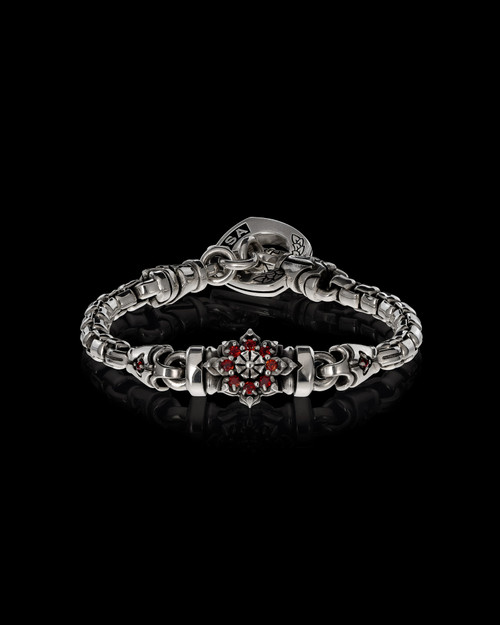Sterling Silver .925 ★ Handcrafted in the USA
Includes premium gift box with polishing cloth.
Sizing Chart
XS 5.5 – 6” wrist - Bracelet end to end 7", Clasped 6"
S 6 – 6.5” wrist - Bracelet end to end 7.5", Clasped 6.5"
M 6.5 – 7” wrist - Bracelet end to end 8", Clasped 7"
L 7 – 7.5” wrist - Bracelet end to end 8.5", Clasped 7.5"
XL 7.5 – 8” wrist - Bracelet end to end 9", Clasped 8"
XXL 8 – 8.5” wrist - Bracelet end to end 9.5", Clasped 8.5"
XXXL 8.5 – 9” wrist - Bracelet end to end 10", Clasped 9"
If you are between sizes, or would like a loose fitting bracelet, please purchase the next size up.
Dimensions
Center Height: 35mm
Chain Diameter: 3mm
Center Gemstone Size: 7mm x 3.5mm
Production & Handling Times
Most NightRider pieces are handcrafted to order, requiring 2-3 weeks of production time. Place your order, and we'll start making it—just for you. LEARN MORE ❯❯
Need your order by a certain date? Call us at 800.566.8661.
Personalizing
Add that extra touch by personalizing your bracelet. Select “Yes” in the Personalizing drop-down. A $250 personalizing fee will be added to your order. One of our Customer Service representatives will reach out to confirm your customization. Or, simply call us at 800.566.8661 to place your order.
Choose up to 7 alphanumeric character on the bar.
Queen's Crown Toggle Bracelet Luxe
Queen's Ring
Queens Collection
Beauty, Strength, & Sovereignty
A Queen is not defined by the crown she wears, but by the strength, wisdom, and grace with which she leads. She carries the weight of her crown with resilience, balancing power and compassion as she shapes her world. This bracelet is a tribute to the wisdom that defines her reign, the love she shares, and the enduring legacy she leaves behind.
Beauty, Strength, & Sovereignty
A Queen is not defined by the crown she wears, but by the strength, wisdom, and grace with which she leads. She carries the weight of her crown with resilience, balancing power and compassion as she shapes her world. This bracelet is a tribute to the wisdom that defines her reign, the love she shares, and the enduring legacy she leaves behind.
Take A Tour
Watch as Rob points out the significance of the symbols found in the Legacy Pendant.
Take A Tour
Watch as Rob points out the significance of the symbols found in the Legacy Pendant.
Key Symbolism
A. Queen’s Crown
Legacy – A crown not just worn, but earned—representing her strength, lineage, and the responsibility she carries.
B. Key
Power – A symbol of her authority, sovereignty, and the capacity to fulfill her divine calling.
C. His & Hers Crowns
Commitment – A symbol of a love where neither stands above the other, but side by side as equals.
D. Keyhole
Companionship – Only a King worthy of her love holds the key to unlock her heart.
E. Flower
Femininity – A symbol of creation, growth, and the timeless beauty that flourishes within her.
Key Symbolism
Take A Tour
Watch as Rob shows off the beauty & symbolism of this bracelet.
A. Queen’s Crown
Legacy – A crown not just worn, but earned—representing her strength, lineage, and the responsibility she carries.
B. Key
Power – A symbol of her authority, sovereignty, and the capacity to fulfill her divine calling.
C. His & Hers Crowns
Commitment – A symbol of a love where neither stands above the other, but side by side as equals.
D. Keyhole
Companionship – Only a King worthy of her love holds the key to unlock her heart.
E. Flower
Femininity – A symbol of creation, growth, and the timeless beauty that flourishes within her.
Product Comparison
| SILVER | LUXE | JAWBONE | |
| | | | |
| Metal(s) | .925 Sterling Silver | .925 Sterling Silver & | 14K Yellow, Rose, or White Gold |
| Standard All Gemstones | Red Garnet Black Onyx Moissanite | Moissanite | Diamond |
| How To Purchase | Custom Made To Order |
SILVER
| Metal | .925 Sterling Silver |
| Standard Gemstones All Gemstones Subject to Availability | Red Garnet Black Onyx Moissanite |
| How To Purchase |
LUXE
| MetalS | .925 Sterling Silver & |
| Standard Gemstones All Gemstones Subject to Availability | Moissanite |
| How To Purchase |
JAWBONE
| MetalS | 14K Yellow, Rose, or White Gold |
| Standard Gemstones All Gemstones Subject to Availability | Diamond |
| How To Purchase | Custom Made To Order |
American Made Jewelry
Next level artistry & craftsmanship. Created right here in the USA.
American Made Jewelry
Next level artistry & craftsmanship.
Created right here in the USA.


















